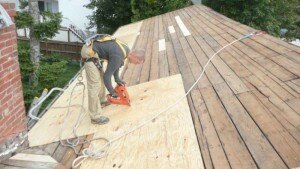It’s Spring time again, and with the Winter finally behind us it’s time to check up on your winter-battered roof and perhaps a good time to start thinking about a new roof!
Image Inspiration Source: Birdseye Design
Spring is also a good time to ask yourself some important questions about your home’s and your roof’s readiness for the upcoming year; Is your home ready for the upcoming Summer, Fall, and Winter? Will your roof hold up to all the heavy snow that will soon start falling and accumulating on your roof next Winter? Have you had any serious trouble with ice dams on your roof last winter? – All of these are good questions to ask yourself, while there is still time to repair or replace that aging roof to make sure that your home is adequately protected for the upcoming winter season.
I do not know about you, but if you ask me, I would tell you that a metal roof is a great way to protect your home if you happen to live in the region that receives a lot of snowfall. – Just ask any resident of Northern New Hampshire, Maine, or Vermont, and they will readily attest to this! 😉
With that being said, If you are still considering installing a new metal roof on your home or commercial property this Summer or early Fall, here are the top 70, most essential metal roofing facts, with FAQs and pros and cons to consider in your buying and decision making process.
In order to help you navigate this long list, we broke it down into the following categories:
Materials Pros & Cons 
Cost of Materials
Installation
Cost of Installation
Colors & Styles
Longevity
Weather Protection
Durability
Maintenance
Energy Efficiency
Environmental Impact
ROI
10 Bonus Facts
 1. Metal roofs can be made from a variety of metals and alloys including Galvanized steel — hot-dip zinc galvanized G-90 and G-60 steel (a less expensive thinner grade steel often used in low-cost corrugated metal panels), Galvalume steel — zinc and aluminum coated steel (A more expensive and longer lasting coating compared to G-90 steel.), stone-coated steel (G-90 galvanized steel), aluminum, copper, zinc, terne (zinc-tin alloy), and stainless steel.
1. Metal roofs can be made from a variety of metals and alloys including Galvanized steel — hot-dip zinc galvanized G-90 and G-60 steel (a less expensive thinner grade steel often used in low-cost corrugated metal panels), Galvalume steel — zinc and aluminum coated steel (A more expensive and longer lasting coating compared to G-90 steel.), stone-coated steel (G-90 galvanized steel), aluminum, copper, zinc, terne (zinc-tin alloy), and stainless steel.
2. The downside of galvanized steel (G-90, and especially G-60) is that it can corrode, eventually, especially when exposed to moist salt spray environment such as in close proximity to coastal areas.
3. Steel is the most frequently used material in both residential and commercial applications, mainly due to its lower cost.
4. Aluminum is the second most popular material. It is more durable and longer lasting than steel, but only costs a fraction of the price of premium metals, such as copper or zinc.



